Beachfront Garden Stands Up to the Elements
This garden sits on Vancouver Island’s dry side, experiencing some of Canada’s mildest weather, but that doesn’t mean landscape designer Jonathan Craggs didn’t face challenging conditions when he was hired to transform an empty waterfront terrace into an enjoyable outdoor living space. “The garden needed to tolerate winter gales, where driftwood might be thrown against the hard landscape,” he says. He also had to contend with the space’s exposure to salty wind spray, browsing deer and foot traffic from the adjacent public beach.
Using the beach as his staging site, Craggs worked on building a space that would not only thrive on the coast but would also enhance the homeowner’s living experience. “I wanted to create a sophisticated environment that would relate to the house interiors,” he says. He also wanted to clearly contrast the designed patio space with the natural landscape of the beach. “The experience of both of these elements is heightened through the contrast,” he says.
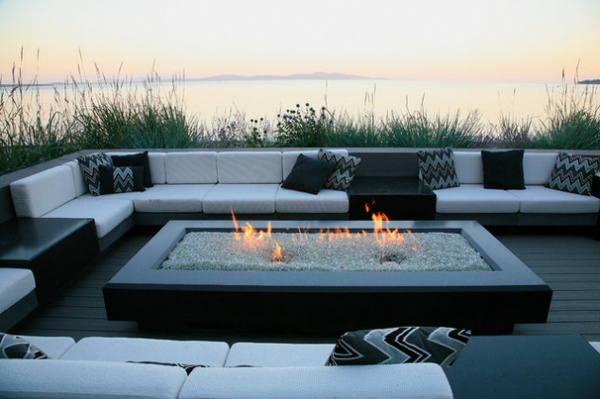
Yard at a Glance
Location: Saanich Peninsula, just north of the city of Victoria, on Vancouver Island, Canada
Size: 288 square feet (26½ square meters)
Craggs brought the patio down to a smaller and more intimate scale by creating this sunken seating area on one side. The seating area shelters those sitting around the fire and also adheres to a local restriction that prohibits hardscape elements from exceeding 2 feet in height. A path from the house to the beach crosses the other side of the yard.
A planted screen provides privacy from beachgoers without blocking the view of Haro Strait, which separates Vancouver from the San Juan Islands. Resilient hardscaping and built-in furniture allow the homeowner to entertain outdoors without worrying about moving furniture indoors when not in use. Cool winds often blow off the beach, so an outdoor fire feature and ambient lighting allow entertaining to flow into the evening.
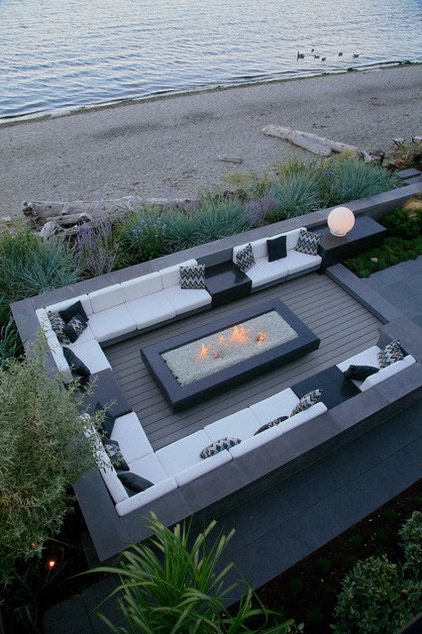
Plants
Craggs planted the patio’s perimeter with shrubs and small trees, with a strip of coast-tolerant perennials along the patio’s ocean side to provide privacy and protection without eliminating the view. He picked plants that could handle direct salt spray, withstand cold winds and survive grazing wildlife. “The presence of deer limited the plant selection,” he says.
The planter’s fullness, contemporary colors and mix of textures bridge the transition from natural beach landscape to clean hardscape. Ornamental grasses and other native and adapted perennials form a soft barrier of foliage and flowers that evolves as the seasons transition. Here are the plants included in that planter:
Blue Wildrye
(Elymus glaucus)
This cool-season North American native grass establishes quickly and is easy to grow, and its arching stems add garden height and fine texture. Seed heads tower above its bluish foliage in fall, before everything turns golden.
Origin: Native across North America, from Alaska south to California and east from North Dakota, then south to Texas, and in New York
Mature size: 2 to 5 feet tall
Benefits and tolerances: Drought, soil and coastal tolerant; rhizomous roots help with erosion control.
Globe Thistle
(Echinops ritro)
Stiff, spiny foliage and architectural flowers add interest to softer plantings. Though the plant reseeds, it does not do so aggressively and can be easily controlled by deadheading.
Origin: Native to central Asia and south-central and southeastern Europe
Where it will grow: Hardy to -40 degrees Fahrenheit (USDA zones 3 to 9; find your zone)
Mature size: 1½ to 3 feet tall
Seasonal interest: Globe-shaped blue or purple flowers July through October
Benefits and tolerances: Reseeds, though not considered invasive; host plant for painted lady butterfly; flowers attract bees
Russian Sage
(Perovskia atriplicifolia)
Small purple flowers, grayish-green leaves and the ability to survive just about anywhere have made Russian sage a mainstay in many temperate-region gardens. While it is a vigorous grower, its resilient nature benefits gardens with more challenging conditions.
Origin: Himalayas, western China
Where it will grow: Hardy to -20 degrees Fahrenheit (zones 5 to 9)
Mature size: 3 to 4 feet tall and wide
Seasonal interest: Flowers summer into fall; architectural stems in winter
Benefits and tolerances: Attracts beneficial insects, bees and hummingbirds; provides seed and fruit for birds
White Thrift
(Armeria maritima ‘Alba’)
This low-growing evergreen perennial naturally grows along coastal cliffs, so it’s right at home in a seaside garden. Its compact mounds don’t spread too much, but white thrift makes a great edging or filler to mix up plant height.
Origin: The straight species is native to Northern hemisphere coasts around the world; ‘Alba’ is a garden cultivar.
Where it will grow: Hardy to -30 degrees Fahrenheit (zones 4 to 8)
Mature size: 5 inches tall
Seasonal interest: Cream-colored globular flowers in spring; grasslike foliage
Benefits and tolerances: Butterflies, moths and bees like the nectar.
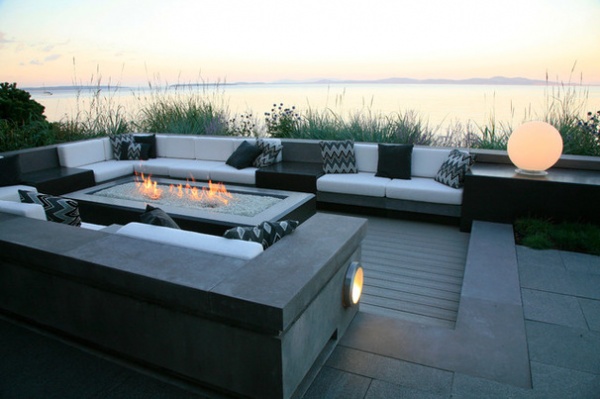
Outdoor Features
Because the garden is constantly exposed to coastal elements and sits next to a public beach, Craggs had all the patio furniture and outdoor features built into the patio. The fireplace sits on a poured-in-place concrete base with a polished and colored precast concrete top. Tempered glass fragments from BlazingGlass cover the burner that sits on top of a metal pan.
The wraparound sofa is also poured-in-place concrete that is finished with a precast concrete cap. Custom cushions soften the space and can easily be brought inside at night or during unfavorable weather. The single globe light is attached to the concrete wall with a metal collar.
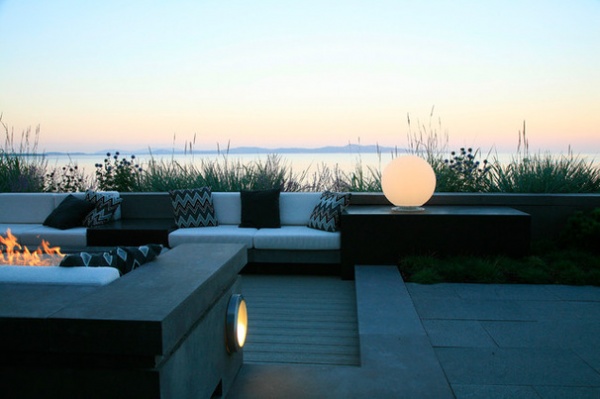
The Hardscape
Neutral, hardworking materials make up the patio’s built features. Craggs chose Trex, a composite decking material, for the sunken deck, matching the color to the decking on the home’s roof. The material is prefinished and should never need to be sanded or restained.
Precast concrete frames the deck, matching the sofa and fire feature, and flamed-finished basalt tile covers the rest of the terrace. Flamed finishing means the stone surface is roughened, which helps with slip resistance.
Read more about decking materials beyond lumber
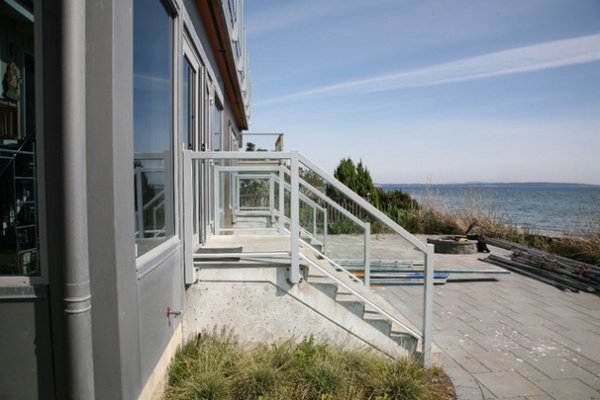
BEFORE: Two sets of stairs originally led from the house out to the empty patio. One set of stairs led from the guest room, and one led from the main portion of the house. After presenting the client with two options, Craggs removed one set of stairs. He also replaced the existing fire pit.
Landscape designer: Jonathan Craggs
General contractor: Jason Powell, Powell Holdings
Masonry contractor: Mike Wiersma, Wiersma Masonry
Gas fire pit mechanical: Majestic Mechanical
Fabric selection: Dawn Garneau, Nygaard Design
Upholstery fabrication: Jeff Rooke, Jayar Uph
More: How to Make Your Oceanfront Garden Thrive












